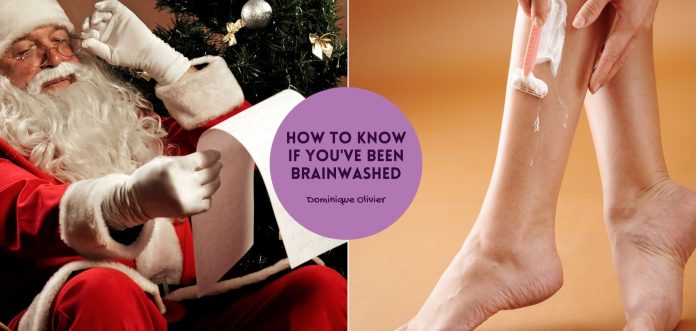How many of our ideas and traditions are our own – and how many have been implanted in our brains in an effort to improve the bottom line of some business?
The world of advertising has a unique and slightly unnerving ability to shape our habits, rituals, and even our mental images of beloved cultural icons. Through various campaigns, clever brands have embedded certain ideas into our minds – often without us even realising.
Coca-Cola: A red and white suit
Quick – think of Santa Claus. What’s the first image that comes to mind?
If the picture you’re imagining involves a portly gentleman with a big white beard, rosy cheeks, and a red suit with white trim, then you’ve been unknowingly influenced by one of the most successful ad campaigns of all time.
Coca-Cola didn’t invent Santa Claus, but their series of ads between the 1930s and 60s went a long way to create a singular, widely-accepted vision of what he looks like. In 1931, the brand approached Michigan-based illustrator Haddon Sundblom to design a warmer, jollier Santa than the one portrayed in their ads in the 1920s (that one looked a bit like a strict school teacher, so a change was clearly due).
World domination via the North Pole was never Coca-Cola’s goal (as far as I can tell) – they simply wanted a better mascot that would help them sell more cola over the festive season. However, Sundblom’s illustrations were so effective at capturing the “ideal Santa” that Coca-Cola continued to roll out ads with that version of Santa for the next three decades. In no time at all, the Santa image created by Sundblom and broadcast by Coca-Cola was adopted by other illustrators as if it were the law. Where Santa had previously been illustrated wearing a variety of colours and garments, the 1930s saw him switch up his wardrobe to exclusively red and white – Coca-Cola’s brand colours, of course.
Sundblom’s Santa ads evolved each year, showing Santa delivering gifts, sharing a Coke with his elves, and even sneaking treats from refrigerators. These playful scenes quickly won over the loyal readers of the magazines they appeared in, who noticed even the smallest changes. When Sundblom once accidentally painted Santa’s belt backwards, fans wrote in, curious about the oversight (as it turned out, Sundblom had modelled for that painting himself and his backward image in the mirror had confused him). Another time, when Santa appeared in a Coke ad without his wedding ring, fans demanded to know what happened to Mrs.Claus.
Sundblom created his final Santa ad for Coca-Cola in 1964, but the company continues to lean on the image that he created to this day – and so does every greeting card company, children’s book, and ornament maker in the world.
Gillette: The concept of a hairless woman
American brand Gillette scored a major deal way back in 1901, shortly after they were founded: they were contracted to supply one safety razor to every soldier in the US Army. In no time at all, this contract made them a household name – but only with men. Not satisfied with winning over only one half of the market, Gillette set its sights on women.
The trouble with that plan was that back in those days, women didn’t shave. Since all dresses of that time had long skirts and sleeves, their body hair simply wasn’t exposed. Now, this may sound odd to you, but the very fact that you are (possibly) a little grossed out when you think of a woman not shaving her legs and underarms is proof of how effective Gillette’s advertising campaign was. In the early 1900s, however, women’s body hair was perceived to be as natural and unproblematic as men’s body hair is today.
Fortunately for Gillette (and unfortunately for every woman who has ever despised having to shave her legs), trends in fashion were shifting. By 1910, sleeveless dresses were becoming the norm, and Gillette pounced on the opportunity to make women feel guilty about having underarm hair. They launched their debut women’s razor, the Milady Décolleté, in 1915, driving it home with an ad campaign that framed underarm shaving as “modern”, while hairy underarms were framed as an “embarrassing” problem that needed a “discreet solution”.
By the 1920s, as women’s skirts got shorter and swimsuits showed more skin, Gillette’s ads evolved to emphasise underarm and leg hair removal as “refinements” for modern, fashionable women. Harper’s Bazaar and other magazines picked up on this, running ads that implied leg and underarm hair needed to be removed to keep up with trends. This subtle but powerful messaging worked; by the 1940s, the majority of body hair removal ads in popular magazines referenced leg shaving for women specifically.
During World War II, a nylon shortage made stockings rare, pushing even more women to bare their legs. Remington quickly introduced the first electric women’s razor, positioning it as a quick, easy way to maintain smooth legs, even without stockings. By then, the trend was well ingrained, and smooth legs and underarms were solidly associated with femininity and grace.
By 1964, an overwhelming 98% of American women ages 15 to 44 were shaving their body hair. Advertisers continued to use subtle shaming tactics to maintain and grow this norm, implying that smooth skin equated to class, beauty and desirability. What began as a desire to sell more safety razors had, by the mid-20th century, turned into a widespread, lasting expectation for women.
De Beers: An expensive commitment
It might surprise you to learn that before 1947, diamonds were not the first choice when it came to creating engagement rings. While they did feature, they shared the stage with other gemstones like emeralds, rubies or sapphires. In fact, until the 1930s, only about 10% of brides received a diamond ring. It wasn’t until De Beers came onto the scene that the idea of a diamond and a lasting commitment became eternally entangled. By the 1990s, more than 80% of engagement rings contained exclusively diamonds.
The company’s iconic campaign, “A diamond is forever,” was coined in 1947 by a young copywriter named Frances Gerety and changed the diamond industry, creating a lasting cultural association between diamonds and romance. De Beers ads suggested that a diamond was not merely a gift, but the ultimate proof of love, enticing men to spend lavishly on these stones. A distinct correlation between the amount spent on the diamond and a young man’s ability to provide for his new wife was created, with taglines encouraging men to spend “two to three months’ salary” on the ring. The bigger the ring, the better perceived the salary.
The campaign’s effect on De Beers’ business was staggering: from 1939 to 1979, their US diamond sales rose from $23 million to $2.1 billion. Advertising spending leaped from $200,000 to $10 million per year, proving to be an extraordinary investment in establishing diamonds as the premier choice for engagement rings.
Ad Age later recognised “A diamond is forever” as the greatest advertising slogan of the 20th century, cementing its place as a pivotal influence on the diamond industry. This slogan not only shaped the modern diamond market but also created a tradition that endures to this day – for better or for worse.
Sunkist: A drinkable orange
It’s a summer morning and you’re ordering breakfast at a nice restaurant. You don’t feel like a hot drink like coffee or tea; you want something cold and refreshing instead. What do you order?
Orange juice, of course. And you have Albert Lasker to thank for that idea.
In the early 20th century, California orange growers had a big problem. Overproduction had driven prices down, and they needed a way to boost demand. Enter Albert Lasker, an advertising aficionado. His first move was to rebrand the cooperative’s complex name to the simple, memorable “Sunkist” – but his real innovation lay in changing how people consumed oranges.
Realising that getting people to buy the same-old-same-old oranges wasn’t going to work, Lasker introduced the concept of drinking orange juice, a new idea at the time. He went on to specifically market orange juice as a fresh, invigorating morning drink, positioning it as the “perfect start to the day.” This move cleverly linked orange juice to breakfast, establishing a ritual that would endure through the ages.
Thanks to Lasker’s efforts, orange juice became the most popular juice in the world, and Sunkist became a household name in the United States. Orange juice reshaped daily habits and created renewed demand for oranges, not only in California but eventually all over the world – even here, at the tip of Africa, where orange juice can be found on practically every breakfast menu in the country.
About the author: Dominique Olivier

Dominique Olivier is the founder of human.writer, where she uses her love of storytelling and ideation to help brands solve problems.
She is a weekly columnist in Ghost Mail and collaborates with The Finance Ghost on Ghost Mail Weekender, a Sunday publication designed to help you be more interesting.
Dominique can be reached on LinkedIn here.





Great article. While Santa shall endure eternally, I am not so sure of other brands which are on a downward trajectory. Take De Beers, for example, which is struggling to fend off existential threats from lab grown diamonds. Its demise, however, spells disaster for Botswana. I would suggest that these two, one corporate entity and one sovereign nation, should really put their heads together and come up with good ideas fast.
As for Antarcatica, a suggestion of placing this valuable continent under the custodianship of the United Nations is vigorously supported.
Marketing at its best 🙂
Loved the article!
What about breakfast cereal and “getting it all this morning”? I also sense an ad campaign shaping the collective belief system. The whole breakfast business seems a bit contrived these days 😅